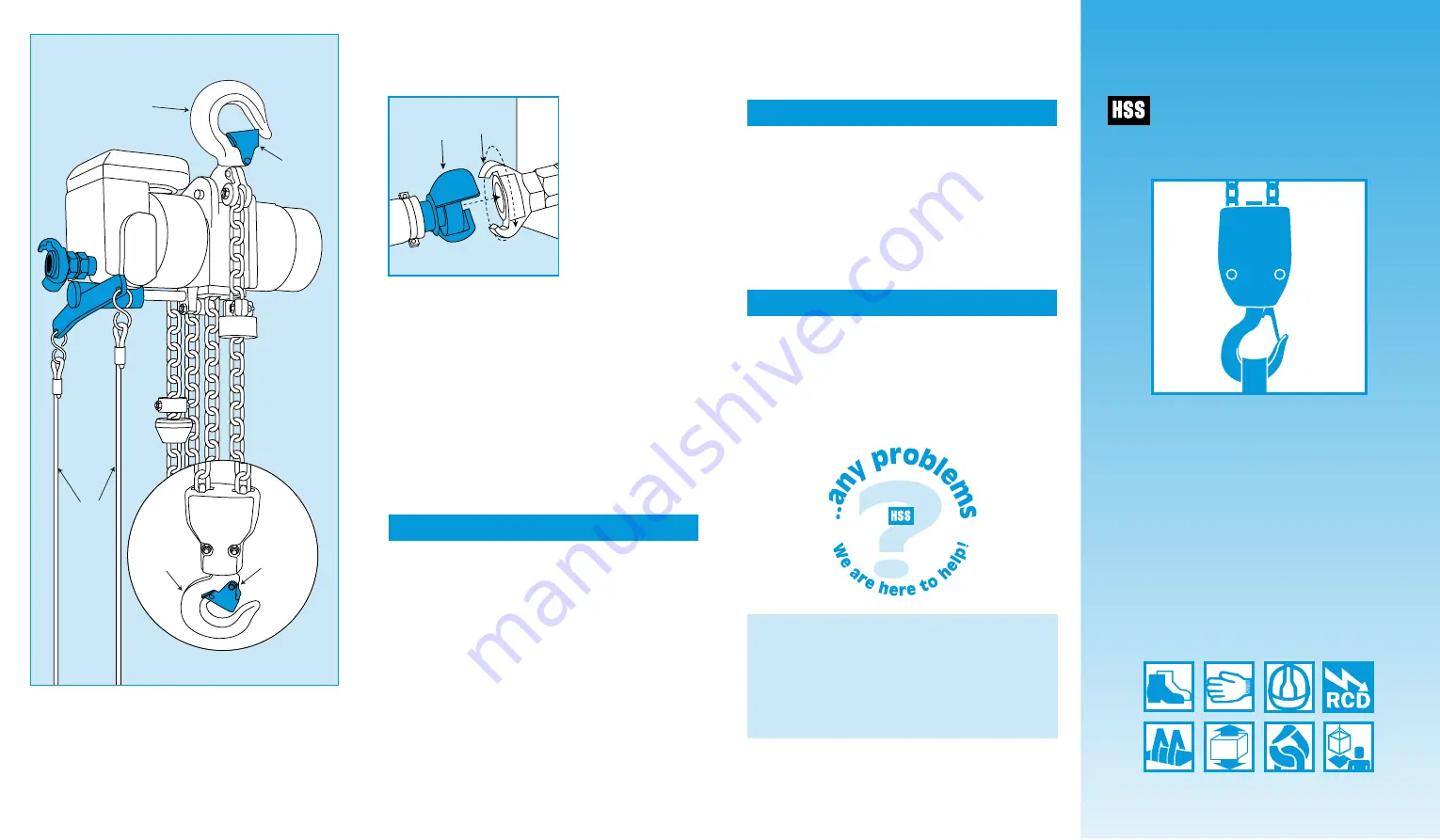
Electric &
Pneumatic
Hoists
Lift & Shift
Electrically and air operated hoists,
simple to install and easy to operate.
Operating & Safety Guide LS64
Allow a 10% safety margin to accommodate
dynamic forces that may arise during the course
of a lift.
If using an electric hoist…
Connect the power supply to the fixed plug on the
unit,
(see illustration).
Either using a suitable fly lead
or alternatively, a loose end cable drum
(available
for hire from your local HSS Lift & Shift Depot).
All the hoist controls are found on the pendent.
To raise a load press the button with the up
arrow. To lower a load, press the button with the
down arrow.
There is a red
emergency stop
button on the
pendent, if pressed
the hoist will stop. To
reset the button turn
it clockwise until it
pops back out.
If using a pneumatic
hoist…
With the compressor
warmed up, and the
air supply valve
CLOSED, connect the air hose by pushing it on to
the valve and turning clockwise.
Anchor the delivery end of the air hose
so that it is
not aimed at any person or property then, taking great
care,
slightly open the air supply valve to clear the
hose of any debris. Now fully close the valve and
turn the compressor OFF.
Lay the hoist down on a clean firm surface,
confirm that its air valve is in the closed position,
and then connect the delivery hose
in the same way
as to the compressor.
Fully
open the air supply valve and start the
compressor.
To raise a load pull on the red control cord, to
lower a load pull on the white pull cord,
Attach the hoist to a suitable tested suspension or
anchorage point, using the body hook. Make sure
the gate is correctly closed before proceeding.
Where the item to be moved has a dedicated
lifting eye this should be used.
If the item has no lifting eye, suitable slings/chains
must be used.
Before lifting, ensure the load is free and not
restrained by fixings etc.
Determine the loads weight and centre of gravity
as accurately as possible.
Attach suitable slings/chains to the load and
attach to the lifting hook ensuring the hook is
not overcrowded and that the hooks gate
closes correctly.
Lift the load a nominal distance to check balance
and security of the load.
BASIC TECHNIQUES
Use tag lines to control long or bulky loads.
Once raised lower as soon as possible. DO NOT
leave the load suspended or unattended for
any reason.
Never push the equipment beyond its design
limits.
If it will not do what you want with reasonable
ease and speed, assume you have the wrong tool for the
job. Contact your local HSS Lift & Shift Depot for advice.
Keep the equipment clean,
you will find this less of a
chore if you clean it regularly, rather than wait until the
end of the hire period.
When not in use
, store the equipment somewhere
clean, dry and safe
from thieves and unauthorised
users.
Lower any raised load and detach from the
lifting hook.
Detach the hoist from its suspension point and
disconnect from the power/air supply and place in
the case provided ready for return
to your local HSS
Lift & Shift Depot.
FINISHING OFF
EQUIPMENT CARE
Code 68931/2/61/2;
69104/5/7/8/9/11/2/3/4/6/21/2/6/32
©HSS Hire Service Group Plc 1999 No. LS64/01
Group Office: 25 Willow Lane, Mitcham, Surrey CR4 4TS
Web Site: http://www.hss-liftandshift.co.uk
Contact your local
0845 704 5116
Lift & Shift
…any comments?
If you have any suggestions to enable us to improve
the information within this guide please fax your
comments or write to the Product Manager at the
address below
Fax: 020 8687 5001
LS64/01
Body
Hook
Gate
Control
Cords
Gate
Lifting
Hook
Pneumatic Hoist
Air
Valve
Air Hose






